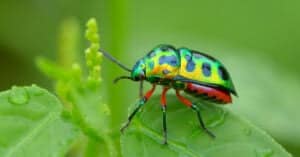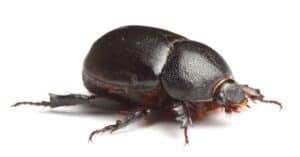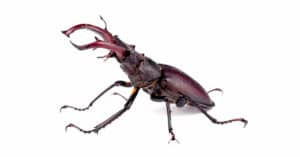Some people are frightened by the term scarab. After all, they were portrayed as insects capable of digging into a person’s body in at least one movie series. While flesh-eating beetles do exist, they are not scarabs and they don’t eat living flesh. In fact, they’re a type of dung beetle. That revelation may raise some questions such as, what is the difference between a dung beetle vs. scarab?
We’ll outline several differences between the dung beetle and scarab so you can see the true nature of scarabs along with how they differ from other members of their family.
Comparing a Dung Beetle and a Scarab
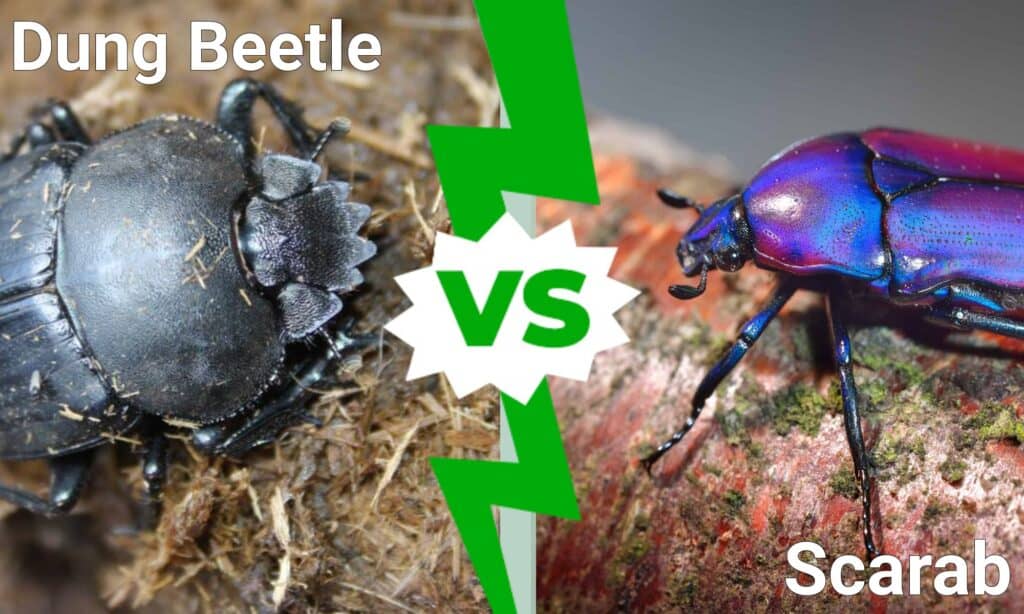
| Dung Beetle | Scarab | |
|---|---|---|
| Size | Weight: up to 3.5 ounces Length: 0.5-2.4 inches | Weight: 1.4 ounces Length: 0.9 to 1.33 inches |
| Morphology | – True dung beetles have mouthparts to help them eat and manipulate dung – They possess molar lobes that help them grind organic parts of the dung – Black, red, and metallic green in color – Males have horns or other structures on their heads that allow them to fight others – Have spurs on their legs that they use to roll dung – Has a tough exoskeleton – Chitinous forewings and membranous hindwings – Capable of pulling up to 250 times their weight or more in some cases | – The beetle’s head has six projections, and the forelegs also have projections – The head’s projections are said to resemble a rising sun, contributing to the religious significance of the beetle in ancient Egypt – The forelegs do not have tarsus like other members of the genus – The legs are believed to have evolved to help dig and manipulate dung – They’re often depicted as black, but they may integrate green, yellow, or deep blue in their coloration – Cannot dig under a person’s flesh to kill them |
| Diet | – True dung beetles eat the feces of other animals, usually from omnivores and herbivores – Consume dung as larvae and liquids from dung when they’re adults | – These beetles roll a ball of dung and then dig a chamber below – They feed on the ball over days |
| Species | – A member of superfamily Scarabaeoidea – Subfamilies Scarabaeinae and Aphodiinae – Scarabaeinae is the subfamily with “true dung beetles” because most feed only on dung – Part of families Geotrupidae and Scarabaeidae | – Scarabaeus sacer – Also known as the sacred scarab – True dung beetle – Type species of dung beetles |
| Range and Habitat | – Live on every continent but Antarctica – Commonly found in forests, deserts, fields, and farmlands – Dung beetles either roll dung to their storage area, tunnel under the dung, or dig into the dung to feed | – Found near the Mediterranean Sea basin – Found in southern Europe, North Africa, and some countries in Asia – They live in dunes, coastal areas, and marshes – Dung beetles lay eggs in smooth dung balls and then the young hatch and eat the dung |
The Key Differences Between a Dung Beetles vs. Scarab
The greatest differences between a dung beetle and a scarab can be found in their size and morphology. Although scarabs are a type of dung beetle, they are smaller than many of their fellow family members, weighing 1.4 ounces and growing up to 1.33 inches long compared to dung beetles as a whole that can weigh upwards of 3.5 inches and grow 2.4 inches in length.
Like other true dung beetles, scarabs have unique mouthparts that help them grab a hold of and eat dung. However, the scarab is unique in that it has projections on its head and forelegs that are said to resemble the rising sun’s rays. Furthermore, scarabs lack the tarsus on their forelegs that other dung beetles possess.
While scarabs are usually depicted as black, other dung beetles can be red, metallic green, or even blue. All dung beetles, including scarabs, are very strong and capable of pulling several times their body weight while rolling their dung balls. However, scarabs aren’t the strongest member of the family.
These unique qualities set scarabs apart from others in the dung beetle family. We’ll explore these creatures in greater detail and show you five major ways that they’re unique from one another.
Dung Beetles vs. Scarab: Size
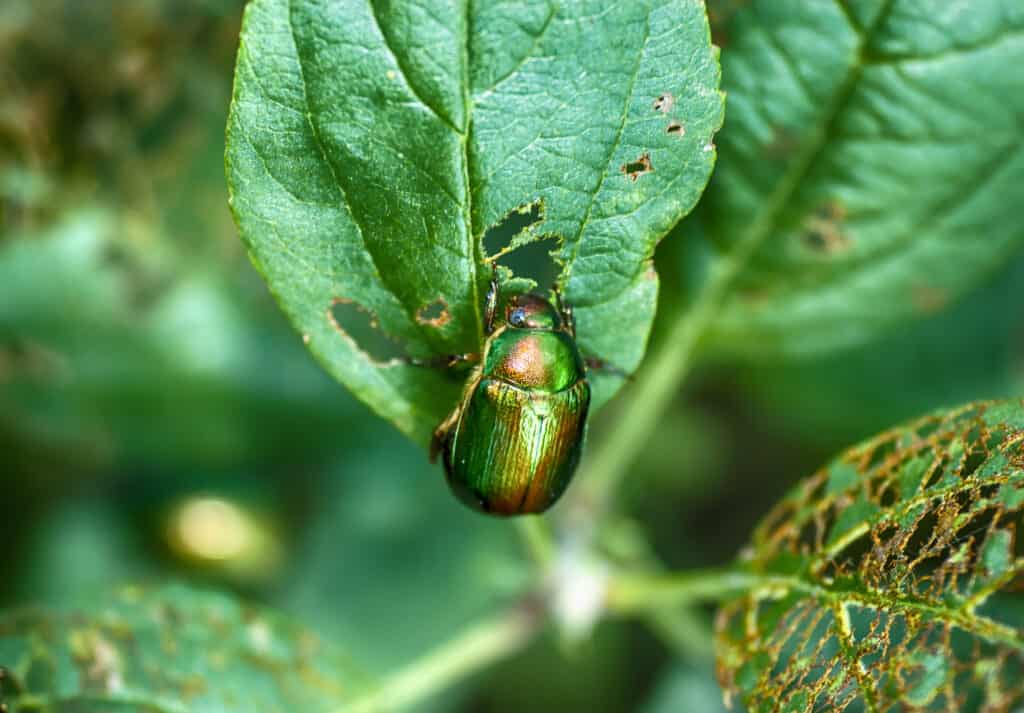
Scarabs are smaller than other dung beetles.
©Costea Andrea M/Shutterstock.com
Scarabs are smaller than many other dung beetles. Scarabs weigh about 1.4 ounces on average while growing from 0.9 to 1.33 inches long. Meanwhile, many other dung beetles weigh up to 3.5 ounces and grow between 0.5 and 2.4 inches in length. This difference isn’t significant, but it shows how scarabs fit in with other members of the family.
Dung Beetles vs. Scarab: Morphology
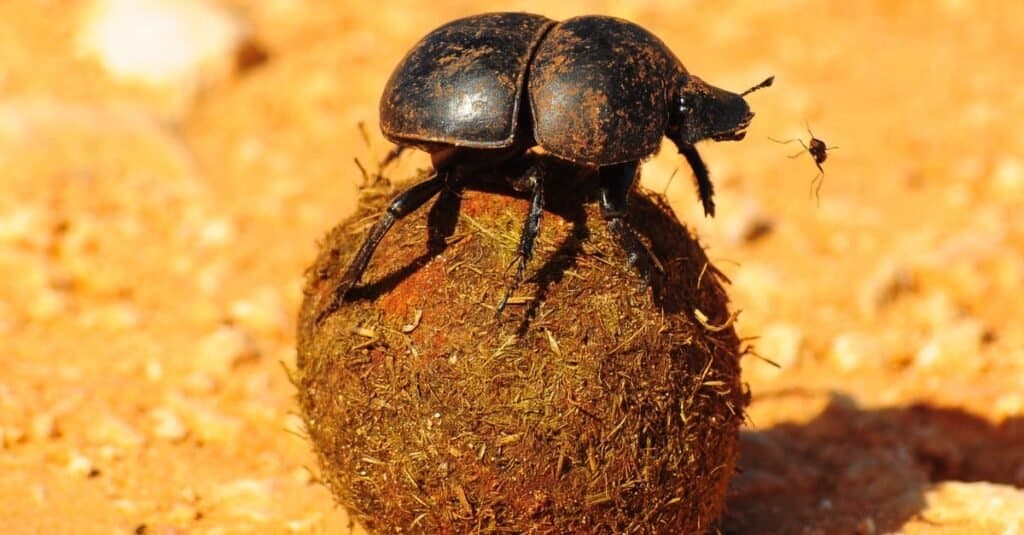
Dung beetles have horn structures for attacking other males.
©Michael Potter11/Shutterstock.com
True dung beetles, like scarabs, have unique mouthparts that let them grind organic pieces in dung. Many dung beetles have horn structures that help males attack other males for mating rights. Meanwhile, scarabs have a rather unique head structure. They have a head with six projections that resemble a rising sun.
Due to those projections, scarabs were once considered sacred in Egypt. Scarabs have unique forelegs that have additional projections like those on their heads, and they lack the tarsus possessed by other members of the dung beetle family. Still, scarabs are strong like other dung beetles, capable of digging into the ground and rolling dung.
Other male dung beetles have different types of head structures used to fight off other beetles for mating rights. Still, dung beetles and scarabs have similarities in their exoskeleton, coloration, and chitinous forewings and softer hindwings.
All in all, it’s easy to see how scarabs have different bodies from other dung beetles, especially those that aren’t true dung beetles.
Dung Beetles vs. Scarab: Diet
Although films portrayed scarabs as flesh-eaters, they actually eat dung. As one might imagine, dung beetles as a whole tend to eat dung. Usually, they’ll eat solid dung when they’re young, but they can eat solid dung or liquids from dung as adults.
Different species of dung beetles can eat dung using various techniques. Scarabs will roll the dung and then dig a chamber below it. They’ll live in the chamber and eat the dung. Some types of dung beetles will burrow directly into the dung. Either way, the way that scarabs eat dung makes it easy to identify them compared to other species.
Dung Beetles vs. Scarab: Species
Dung beetles are members of the superfamily Scarabaeoidea. They have members in Geotrupidae and Scarabaeidae families. Furthermore, they have members in the subfamilies Scarabaeinae and Aphodiinae, and the former is considered the true dung beetles because of their habit of consuming dung.
Meanwhile, scarabs descend from the Scarabaeidae family, and their species name is Scarabaeus sacer. They’re the type genus of the dung beetle, so they’re one of the most recognizable species of dung beetles in existence. They’re some of the truest of the true dung beetles!
Dung Beetles vs. Scarab: Range and Habitat
While dung beetles are found on every continent except Antarctica, scarabs are only found in Europe, Africa, and parts of Asia. In fact, they’re only found in the areas of the Mediterranean Basin. That includes North Africa, southern Europe, and the westernmost reaches of Asia.
Dung beetles commonly live in forests, fields, deserts, and farmlands, but scarabs live in coastal areas like marshes as well as dunes.
All told, scarabs are certainly alike other members of the dung beetle family. However, they are unique in their body shape, historical context, and the areas in which they live.
Up Next:
- Click Beetle vs Cockroach: What are the Differences?
- Stag Beetle vs. Hercules Beetle — An Epic Beetle Battle
- Carpet Beetle vs Bed Bug: What are the Differences?
- Cigarette Beetle vs Drugstore Beetle: What are the Differences?
The photo featured at the top of this post is © Mike Laptev/Shutterstock.com
Sources
- University of Wisconsin, Available here: https://uwm.edu/field-station/dung-beetle/#:~:text=DUNG%20BEETLE%20FUN%20FACTS&text=A%20dung%20beetle%20may%20fly,is%20in%20a%20single%20night.
Thank you for reading! Have some feedback for us? Contact the AZ Animals editorial team.



